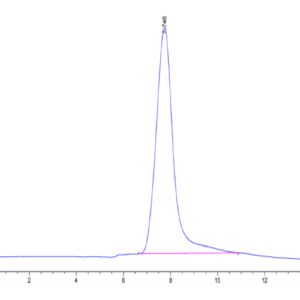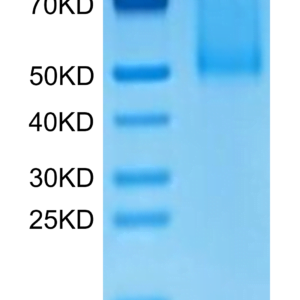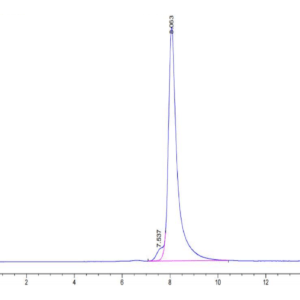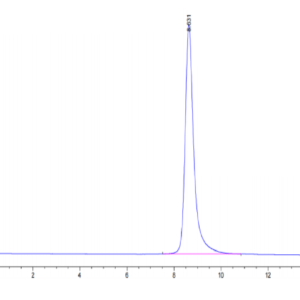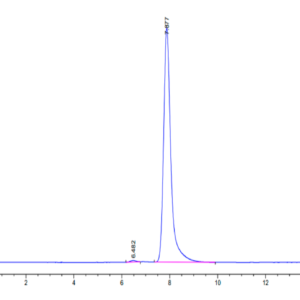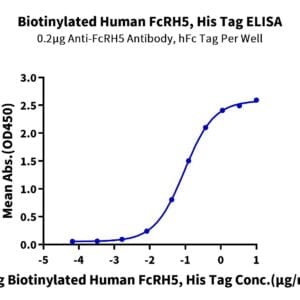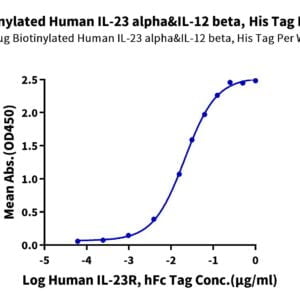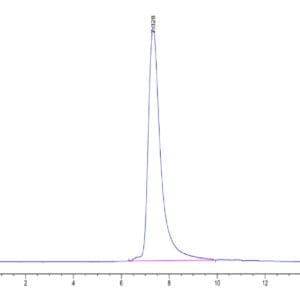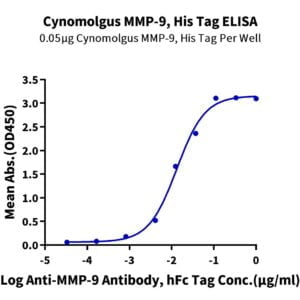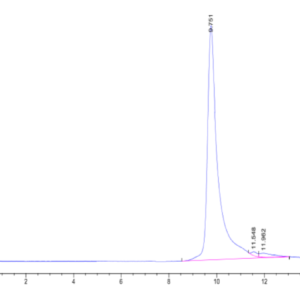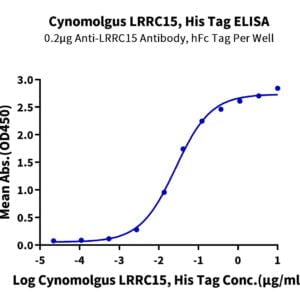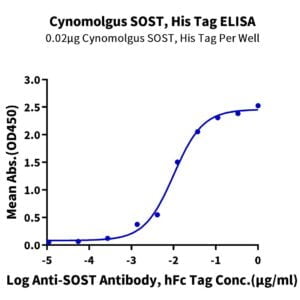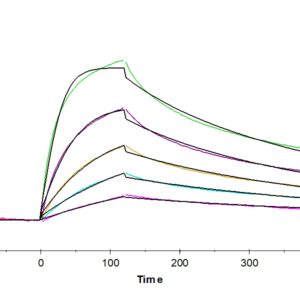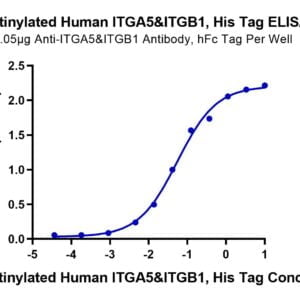| Weight | 1 lbs |
|---|---|
| Dimensions | 9 × 5 × 2 in |
| accession | P31809 |
| express system | HEK293 |
| product tag | C-His |
| purity | > 95% as determined by Tris-Bis PAGE;> 95% as determined by HPLC |
| background | Carcinoembryonic antigen-related cell adhesion molecule 1 (CEACAM-1) is the major antigen of the CD66 cluster of granulocyte differentiation antigens. The present study aimed to assess the biological function of CEACAM-1 on the growth of human colorectal cancer (CRC) cells in vitro. |
| molecular weight | The protein has a predicted MW of 44.7 kDa. Due to glycosylation, the protein migrates to 75-110 kDa based on Tris-Bis PAGE result. |
| available size | 100 µg, 500 µg |
| endotoxin | Less than 1EU per ug by the LAL method. |
Mouse CEACAM-1/CD66a Protein 3481
$270.00 – $900.00
Summary
- Expression: HEK293
- Pure: Yes (HPLC)
- Amino Acid Range: Glu35-Gly428
Mouse CEACAM-1/CD66a Protein 3481
| protein |
|---|
| Size and concentration 100, 500µg and lyophilized |
| Form Lyophilized |
| Storage Instructions Valid for 12 months from date of receipt when stored at -80°C. Recommend to aliquot the protein into smaller quantities for optimal storage. Please minimize freeze-thaw cycles. |
| Storage buffer Shipped at ambient temperature. |
| Purity > 95% as determined by Tris-Bis PAGE |
| target relevance |
|---|
| Carcinoembryonic antigen-related cell adhesion molecule 1 (CEACAM-1) is the major antigen of the CD66 cluster of granulocyte differentiation antigens. The present study aimed to assess the biological function of CEACAM-1 on the growth of human colorectal cancer (CRC) cells in vitro. |
| Protein names Carcinoembryonic antigen-related cell adhesion molecule 1 (Biliary glycoprotein 1) (BGP-1) (Biliary glycoprotein D) (MHVR1) (Murine hepatitis virus receptor) (MHV-R) (CD antigen CD66a) |
| Gene names Ceacam1,Ceacam1 Bgp Bgp1 |
| Protein family Immunoglobulin superfamily, CEA family |
| Mass 10090Da |
| Function [Isoform 1]: Cell adhesion protein that mediates homophilic cell adhesion in a calcium-independent manner (By similarity). Plays a role as coinhibitory receptor in immune response, insulin action and functions also as an activator during angiogenesis (PubMed:16680193, PubMed:17081782, PubMed:18544705, PubMed:21029969, PubMed:21081647, PubMed:22496641, PubMed:22962327, PubMed:23696226). Its coinhibitory receptor function is phosphorylation- and PTPN6 -dependent, which in turn, suppress signal transduction of associated receptors by dephosphorylation of their downstream effectors (PubMed:17081782, PubMed:21029969, PubMed:22496641). Plays a role in immune response, of T-cells, natural killer (NK) and neutrophils (PubMed:17081782, PubMed:21029969, PubMed:22496641, PubMed:23696226). Upon TCR/CD3 complex stimulation, inhibits TCR-mediated cytotoxicity by blocking granule exocytosis by mediating homophilic binding to adjacent cells, allowing interaction with and phosphorylation by LCK and interaction with the TCR/CD3 complex which recruits PTPN6 resulting in dephosphorylation of CD247 and ZAP70 (PubMed:22496641). Also inhibits T-cell proliferation and cytokine production through inhibition of JNK cascade and plays a crucial role in regulating autoimmunity and anti-tumor immunity by inhibiting T-cell through its interaction with HAVCR2 (PubMed:17081782). Upon natural killer (NK) cells activation, inhibit KLRK1-mediated cytolysis of CEACAM1-bearing tumor cells by trans-homophilic interactions with CEACAM1 on the target cell and lead to cis-interaction between CEACAM1 and KLRK1, allowing PTPN6 recruitment and then VAV1 dephosphorylation (PubMed:23696226). Upon neutrophils activation negatively regulates IL1B production by recruiting PTPN6 to a SYK-TLR4-CEACAM1 complex, that dephosphorylates SYK, reducing the production of reactive oxygen species (ROS) and lysosome disruption, which in turn, reduces the activity of the inflammasome (PubMed:22496641). Down-regulates neutrophil production by acting as a coinhibitory receptor for CSF3R by downregulating the CSF3R-STAT3 pathway through recruitment of PTPN6 that dephosphorylates CSF3R (PubMed:21029969). Also regulates insulin action by promoting INS clearance and regulating lipogenesis in liver through regulating insulin signaling (PubMed:18544705). Upon INS stimulation, undergoes phosphorylation by INSR leading to INS clearance by increasing receptor-mediated insulin endocytosis. This inernalization promotes interaction with FASN leading to receptor-mediated insulin degradation and to reduction of FASN activity leading to negative regulation of fatty acid synthesis. INSR-mediated phosphorylation also provokes a down-regulation of cell proliferation through SHC1 interaction resulting in decrease coupling of SHC1 to the MAPK3/ERK1-MAPK1/ERK2 and phosphatidylinositol 3-kinase pathways (By similarity). Functions as activator in angiogenesis by promoting blood vessel remodeling through endothelial cell differentiation and migration and in arteriogenesis by increasing the number of collateral arteries and collateral vessel calibers after ischemia (PubMed:16680193, PubMed:22962327). Also regulates vascular permeability through the VEGFR2 signaling pathway resulting in control of nitric oxide production (PubMed:21081647). Down-regulates cell growth in response to EGF through its interaction with SHC1 that mediates interaction with EGFR resulting in decrease coupling of SHC1 to the MAPK3/ERK1-MAPK1/ERK2 pathway (PubMed:15467833). Negatively regulates platelet aggregation by decreasing platelet adhesion on type I collagen through the GPVI-FcRgamma complex (PubMed:19008452). Inhibits cell migration and cell scattering through interaction with FLNA; interferes with the interaction of FLNA with RALA (By similarity). Mediates bile acid transport activity in a phosphorylation dependent manner (By similarity). Negatively regulates osteoclastogenesis (PubMed:25490771).; [Isoform 2]: Cell adhesion protein that mediates homophilic cell adhesion in a calcium-independent manner (PubMed:1633107). Promotes populations of T-cells regulating IgA production and secretion associated with control of the commensal microbiota and resistance to enteropathogens (PubMed:23123061).; (Microbial infection) In case of murine coronavirus (MHV) infection, serves as receptor for MHV S1 spike glycoprotein. |
| Catalytic activity #N/A |
| Subellular location [Isoform 1]: Cell membrane ; Single-pass type I membrane protein. Lateral cell membrane. Apical cell membrane. Basal cell membrane. Cell junction. Cell junction, adherens junction. Note=Canalicular domain of hepatocyte plasma membranes. Found as a mixture of monomer, dimer and oligomer in the plasma membrane. Occurs predominantly as cis-dimers and/or small cis-oligomers in the cell junction regions. Found as dimer in the solution. Predominantly localized to the lateral cell membranes.; [Isoform 2]: Cell membrane ; Single-pass type I membrane protein. Lateral cell membrane. Apical cell membrane. Basal cell membrane. Cell junction. Cell junction, adherens junction. Cytoplasmic vesicle, secretory vesicle. Note=Predominantly localized to the lateral cell membranes. Found as a mixture of monomer, dimer and oligomer in the plasma membrane. Occurs predominantly as cis-dimers and/or small cis-oligomers in the cell junction regions (By similarity). Co-localizes with ANXA2 in secretory vesicles and with S100A10/p11 at the plasma membrane (By similarity).; Cell projection, microvillus membrane ; Single-pass type I membrane protein. Apical cell membrane ; Single-pass type I membrane protein. Note=Localized to the apical glycocalyx surface (By similarity). Colocalizes with CEACAM20 at the apical brush border of intestinal cells (PubMed:25908210). |
| Tissues Expressed in granulocytes, lymphocytes, granulocytes, B cells, and T-cells (PubMed:11994468). Expressed in bone. Highly expressed in liver and femur (PubMed:25490771). Highly expressed in neutrophils, and to a lesser extent inmonocytes, and macrophages. Slightly higher expressed in peripheral blood neutrophils (PBNs) (PubMed:21029969). Intestinal T-cells predominantly express isoform 2 while extraintestinal T-cells mainly express isoform 1 (PubMed:23123061). Expressed in small intestine and colon (PubMed:25908210). |
| Structure (Microbial infection) Interacts with MHV S1 spike glycoprotein.; Monomer. Oligomer. Heterodimer. Homodimer (By similarity). Cis-dimer/oligomer (via Ig-like C2-type and/or via cytoplasmic domains); induced by trans-homophilic cell adhesion through an allosteric mechanism transmitted by the Ig-like V-type domain, and is regulated by intracellular calcium and calmodulin. Interacts (via cytoplasmic domain) with calmodulin in a calcium dependent manner; reduces homophilic cell adhesion through dissociation of dimer (By similarity). Isoform 1 interacts (via cytoplasmic domain) with PTPN11 (preferentially) and PTPN6; cis-homodimer form is preferred; this interaction is decreased by formation of isoform 1 / isoform 2 cis-heterodimers and is dependent on the monomer/dimer equilibrium; this interaction is phosphorylation-dependent (PubMed:9867848). Isoform 1 interacts with LYN (PubMed:22496641). Isoform 1 interacts (via cytoplasmic domain) with SRC (via SH2 domain); this interaction is regulated by trans-homophilic cell adhesion (By similarity). Isoform 1 interacts with LCK; mediates phosphorylation at Tyr-488 and Tyr-515 resulting in PTPN6 association. Isoform 1 interacts with PTPN6; this interaction is phosphorylation-dependent and causes a profound decrease in TCR stimulation-induced CD247 and ZAP70 phosphorylation. Isoform 1 interacts with TCR/CD3 complex through TCR beta chain and CD3E; colocalizes at the cell surface and upon stimulation of the TCR/CD3 complex recruits PTPN6 in the TCR/CD3 complex, resulting in dephosphorylation of CD247 and ZAP70 (By similarity). Isoform 1 interacts (via cytoplasmic domain) with SHC1 (via SH2 domain); SHC1 mediates interaction with INSR or EGFR in a Ser-503 phosphorylation-dependent manner (PubMed:15467833). Isoform 1 interacts with EGFR; the interaction is indirect (By similarity). Isoform 1 interacts with CSF3R; down-regulates the CSF3R-STAT3 pathway through recruitment of PTPN6 that dephosphorylates CSF3R (PubMed:21029969). Isoform 1 (phosphorylated form) interacts with TLR4 and SYK; recruits PTPN6 that dephosphorylates SYK, reducing the production of reactive oxygen species (ROS) and lysosome disruption, leading to a reduction of the inflammasome activity (PubMed:22496641). Isoform 1 interacts with FLNA; inhibits cell migration and cell scattering by interfering with the interaction of FLNA with RALA. Isoform 1 interacts (via cytoplasmic domain) with PXN; the interaction is phosphotyrosyl-dependent. Isoform 1 interacts with KLRK1; recruits PTPN6 that dephosphorylates VAV1. Isoform 1 interacts with CEACAM8 (By similarity). Isoform 1 interacts with FASN; this interaction is insulin and phosphorylation-dependent; reduces fatty-acid synthase activity (By similarity). Interacts (via Ig-like V-type) with HAVCR2 (via Ig-like V-type); facilitates the maturation and cell surface expression of HAVCR2 thereby regulating T-cell tolerance induction (By similarity) (PubMed:25363763). Isoform 2 interacts (via the cytoplasmic domain) with ANXA2; this interaction is regulated by phosphorylation and appears in the AIIt complex. Interacts (via Lewis X moieties) with CD209 (via C-type lectin domain); this interaction is regulated by the glycosylation pattern of CEACAM1 on cell types and regulates contact between dendritic cells and neutrophils (By similarity). |
| Post-translational modification [Isoform 1]: Phosphorylated on serine and tyrosine (By similarity). Isoform 1 is phosphorylated on tyrosine by Src family kinases like SRC and LCK and by receptor like CSF3R, EGFR and INSR upon stimulation (PubMed:21029969, PubMed:9867848). Phosphorylated at Ser-503; mediates activity. Phosphorylated at Tyr-488; regulates activity (By similarity). Phosphorylated at Tyr-488 by EGFR and INSR upon stimulation; this phosphorylation is Ser-503-phosphorylation-dependent; mediates cellular internalization; increases interaction with FASN (By similarity). Phosphorylated at Tyr-488 and Tyr-515 by LCK; mediates PTPN6 association and is regulated by homophilic ligation of CEACAM1 in the absence of T-cell activation (By similarity). Phosphorylated at Tyr-515; mediates interaction with PTPN11 (PubMed:9867848).; [Isoform 2]: Phosphorylated on serine and threonine. |
| Domain Ig |
| Target Relevance information above includes information from UniProt accession: P31809 |
| The UniProt Consortium |
Data
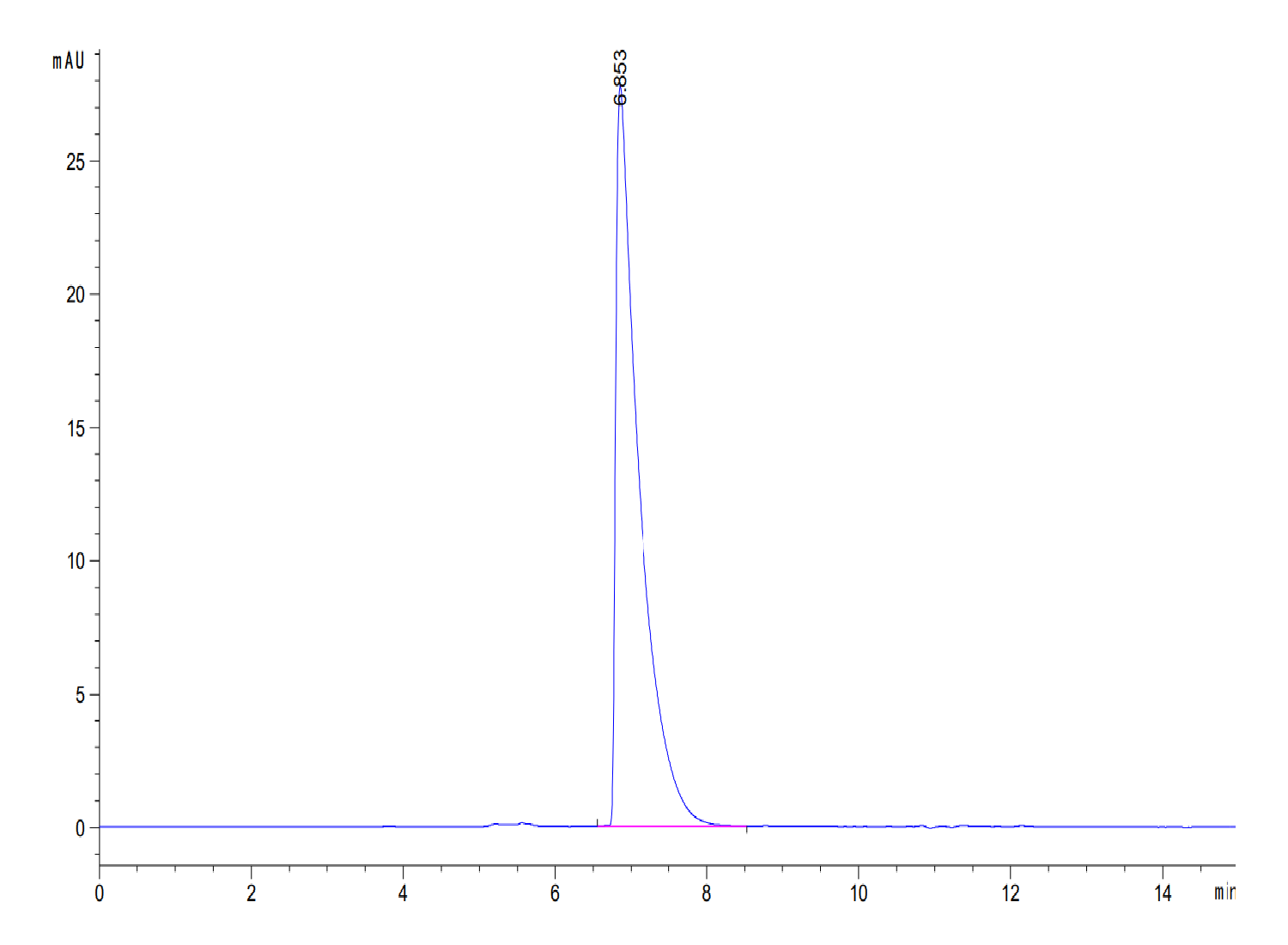 |
| The purity of Mouse CEACAM-1 is greater than 95% as determined by SEC-HPLC. |
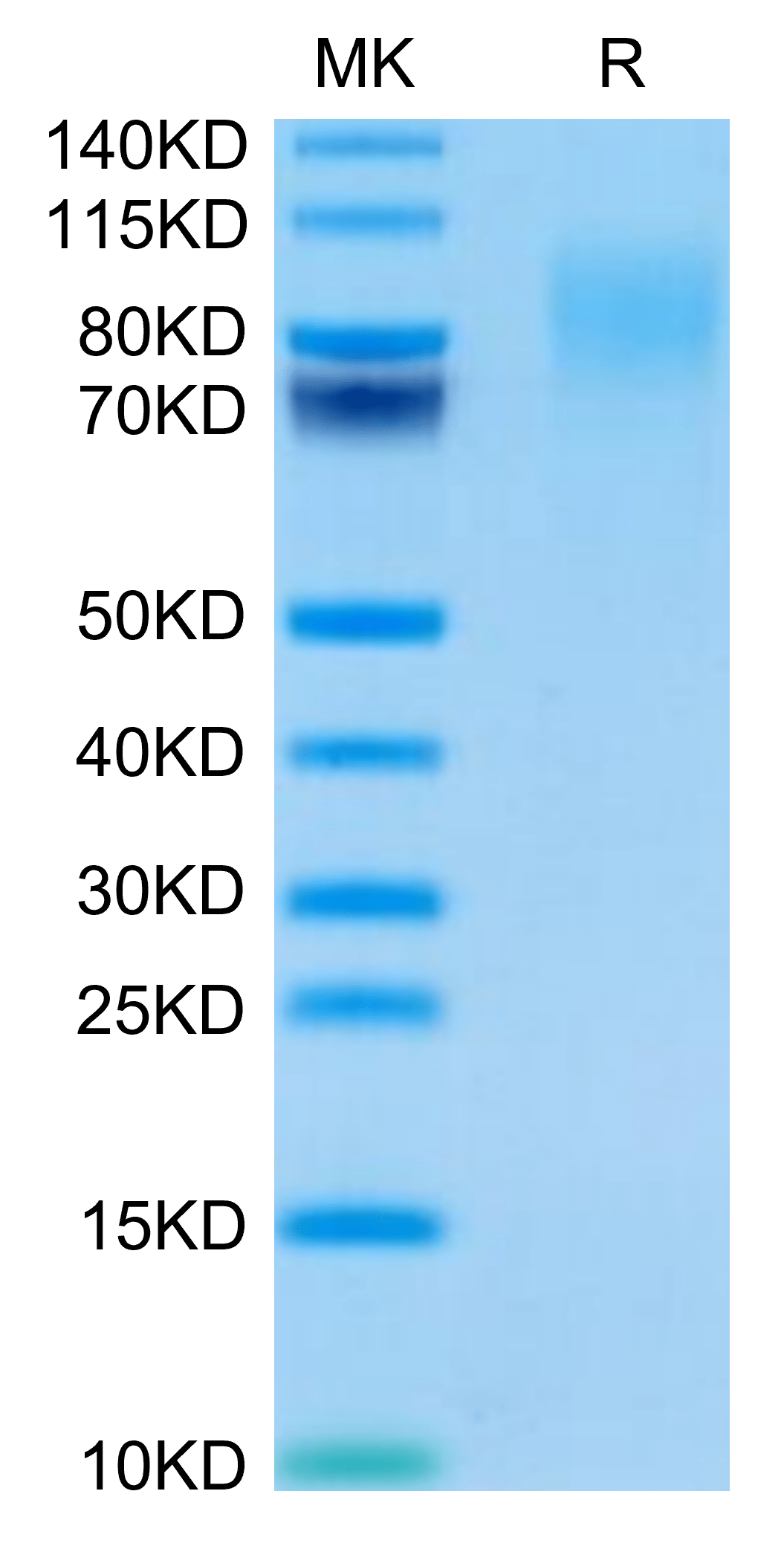 |
| Mouse CEACAM-1 on Tris-Bis PAGE under reduced condition. The purity is greater than 95%. |
Publications
Publications
| pmid | title | authors | citation |
|---|---|---|---|
| We haven't added any publications to our database yet. | |||
Protocols
| relevant to this product |
|---|
Documents
| # | ||
|---|---|---|
| Please enter your product and batch number here to retrieve product datasheet, SDS, and QC information. | ||
